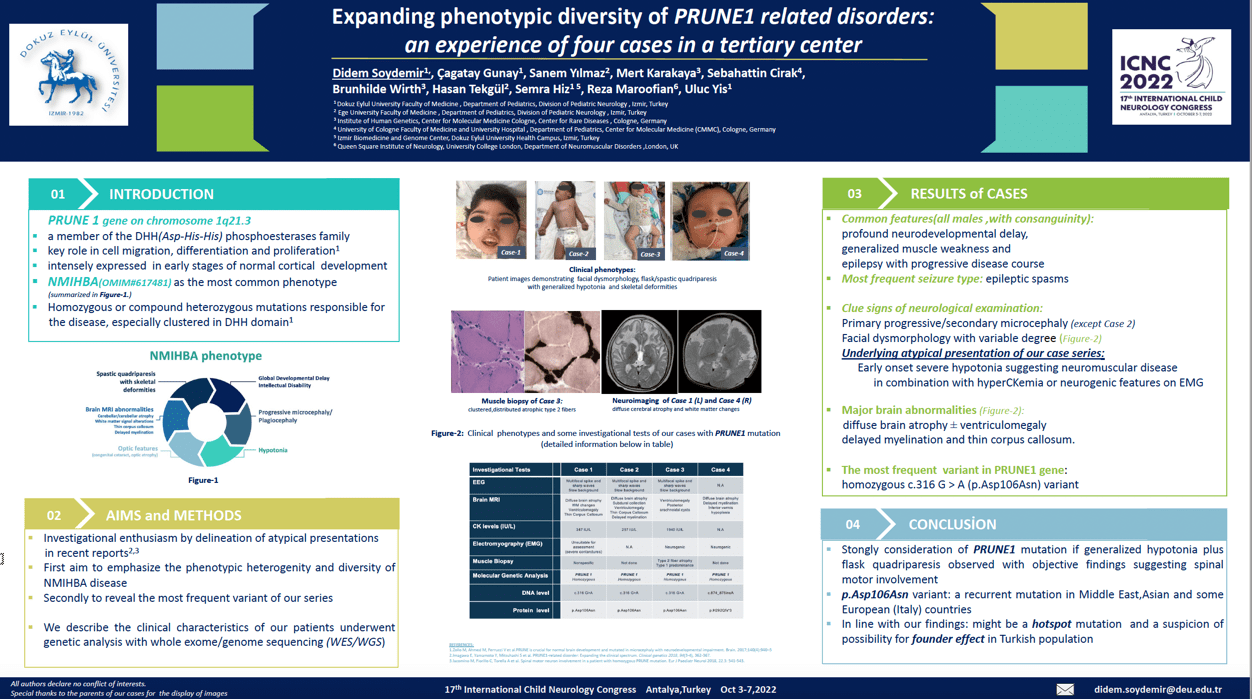EXPANDING PHENOTYPIC DIVERSITY OF PRUNE1 RELATED DISORDERS: AN EXPERIENCE OF FOUR CASES IN A TERTIARY CENTER
Didem Soydemir, Cagatay Gunay, Sanem Yılmaz , Mert Karakaya, Sebahattin Cirak, Brunhilde Wirth, Hasan Tekgul, Semra Hiz Kurul, Reza Maroofian , Uluc Yis
OBJECTIVES: PRUNE1(Prune exopolyphosphatase-1),a member of phosphodiesterase superfamily,is a gene responsible for normal cortical development.Biallelic loss-of-function variants of this gene lead to the disease NMIHBA(OMIM#617481;neurodevelopmental disorder with microcephaly,hypotonia,variable brain abnormalities).The main clinical symptoms are developmental delay,early onset hypotonia resulting in spastic/flask quadriparesis and epilepsy. Signs of spinal motor neuron involvement as a rare presentation also fortify the phenotypic heterogenity of the disease.In our case series, we aimed to emphasize the phenotypic diversity of PRUNE1 related disorders.
MATERIALS and METHODS: Whole exome(Case1/2/3) or genome(Case4) sequencing were performed.Karyotype analysis,microarray CGH and SMN gene analysis were among other genetic tests applied before.
RESULTS: Common features of our cases were profound developmental delay, generalized muscle weakness and epilepsy with progressive disease course as summarized in Table-1. All cases needed early respiratory and nutritional support.The most common seizure type was epileptic spasm.All cases had microcephaly(except case2) with mild facial dysmorphology(except Case1).Major brain abnormalities were diffuse brain atrophy ± ventriculomegaly and delayed myelination with thin corpus callosum.Early onset hypotonia with quadriparesis(spastic/flask) and skeletal deformities were pervasive neurological signs suggesting neuromuscular involvement.Electromyography of Case3 and 4 displayed neurogenic discharges with denervation.CK levels were in a range of 347-1940 IU/L.The most common variant in PRUNE1 gene was homozygous c.316 G > A(p.D106N) variant.
CONCLUSION: Although NMIHBA is the core phenotype of PRUNE1 related disorders, PRUNE1 mutations should also be considered in a patient with congenital hypotonia related to elevated CK levels and neurogenic EMG findings.Also c.316 G > A(p.D106N) may be common variant in Turkish population.
Keywords: PRUNE1, microcephaly, neurogenic, quadriparesis, cortical atrophy
Didem Soydemir
Dokuz Eylul Unıversıty Faculty of Medıcıne,Izmir,Turkey
Turkey
Cagatay Gunay
Dokuz Eylul Unıversıty Faculty of Medıcıne,Izmir,Turkey
Turkey
Sanem Yılmaz
Ege University Faculty of Medicine,Izmir,Turkey
Turkey
Mert Karakaya
Institute for Genetics, University of Cologne,Germany
Germany
Sebahattin Cirak
University of Cologne,Faculty of Medicine and University Hospital ,Cologne
Germany
Brunhilde Wirth
Institute for Genetics, University of Cologne,Germany
Germany
Hasan Tekgul
Ege University Faculty of Medicine,Izmir,Turkey
Turkey
Semra Hiz Kurul
Dokuz Eylul Unıversıty Faculty of Medıcıne,Izmir,Turkey
Turkey
Reza Maroofian
Queen Square Institute of Neurology, University College London, London, UK
United Kingdom
Uluc Yis
Dokuz Eylul Unıversıty Faculty of Medıcıne,Izmir,Turkey
Turkey
OBJECTIVES: PRUNE1(Prune exopolyphosphatase-1),a member of phosphodiesterase superfamily,is a gene responsible for normal cortical development.Biallelic loss-of-function variants of this gene lead to the disease NMIHBA(OMIM#617481;neurodevelopmental disorder with microcephaly,hypotonia,variable brain abnormalities).The main clinical symptoms are developmental delay,early onset hypotonia resulting in spastic/flask quadriparesis and epilepsy. Signs of spinal motor neuron involvement as a rare presentation also fortify the phenotypic heterogenity of the disease.In our case series, we aimed to emphasize the phenotypic diversity of PRUNE1 related disorders.
MATERIALS and METHODS: Whole exome(Case1/2/3) or genome(Case4) sequencing were performed.Karyotype analysis,microarray CGH and SMN gene analysis were among other genetic tests applied before.
RESULTS: Common features of our cases were profound developmental delay, generalized muscle weakness and epilepsy with progressive disease course as summarized in Table-1. All cases needed early respiratory and nutritional support.The most common seizure type was epileptic spasm.All cases had microcephaly(except case2) with mild facial dysmorphology(except Case1).Major brain abnormalities were diffuse brain atrophy ± ventriculomegaly and delayed myelination with thin corpus callosum.Early onset hypotonia with quadriparesis(spastic/flask) and skeletal deformities were pervasive neurological signs suggesting neuromuscular involvement.Electromyography of Case3 and 4 displayed neurogenic discharges with denervation.CK levels were in a range of 347-1940 IU/L.The most common variant in PRUNE1 gene was homozygous c.316 G > A(p.D106N) variant.
CONCLUSION: Although NMIHBA is the core phenotype of PRUNE1 related disorders, PRUNE1 mutations should also be considered in a patient with congenital hypotonia related to elevated CK levels and neurogenic EMG findings.Also c.316 G > A(p.D106N) may be common variant in Turkish population.
Keywords: PRUNE1, microcephaly, neurogenic, quadriparesis, cortical atrophy
Didem Soydemir
Dokuz Eylul Unıversıty Faculty of Medıcıne,Izmir,Turkey
Turkey
Cagatay Gunay
Dokuz Eylul Unıversıty Faculty of Medıcıne,Izmir,Turkey
Turkey
Sanem Yılmaz
Ege University Faculty of Medicine,Izmir,Turkey
Turkey
Mert Karakaya
Institute for Genetics, University of Cologne,Germany
Germany
Sebahattin Cirak
University of Cologne,Faculty of Medicine and University Hospital ,Cologne
Germany
Brunhilde Wirth
Institute for Genetics, University of Cologne,Germany
Germany
Hasan Tekgul
Ege University Faculty of Medicine,Izmir,Turkey
Turkey
Semra Hiz Kurul
Dokuz Eylul Unıversıty Faculty of Medıcıne,Izmir,Turkey
Turkey
Reza Maroofian
Queen Square Institute of Neurology, University College London, London, UK
United Kingdom
Uluc Yis
Dokuz Eylul Unıversıty Faculty of Medıcıne,Izmir,Turkey
Turkey

Didem Soydemir
Dokuz Eylul Unıversıty Faculty of Medıcıne,Izmir,Turkey Turkey
Dokuz Eylul Unıversıty Faculty of Medıcıne,Izmir,Turkey Turkey